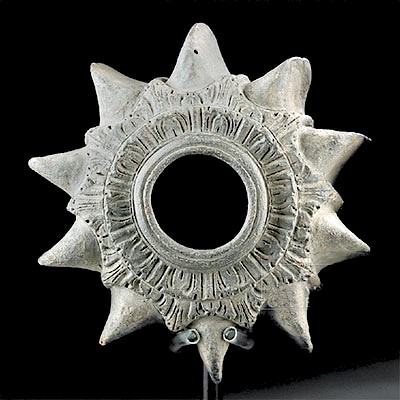Large & Superb Cocle Macaracas Polychrome Jar
Lot 52a
About Seller
Artemis Fine Arts
686 S Taylor Ave, Ste 106
Louisville, CO 80027
United States
Selling antiquities, ancient and ethnographic art online since 1993, Artemis Gallery specializes in Classical Antiquities (Egyptian, Greek, Roman, Near Eastern), Asian, Pre-Columbian, African / Tribal / Oceanographic art. Our extensive inventory includes pottery, stone, metal, wood, glass and textil...Read more
Estimate:
$4,000 - $6,000
Absentee vs Live bid
Two ways to bid:
- Leave a max absentee bid and the platform will bid on your behalf up to your maximum bid during the live auction.
- Bid live during the auction and your bids will be submitted real-time to the auctioneer.
Bid Increments
| Price | Bid Increment |
|---|---|
| $0 | $25 |
| $300 | $50 |
| $1,000 | $100 |
| $2,000 | $250 |
| $5,000 | $500 |
| $10,000 | $1,000 |
| $20,000 | $2,500 |
| $50,000 | $5,000 |
| $100,000 | $10,000 |
| $200,000 | $20,000 |
About Auction
By Artemis Fine Arts
Jul 25, 2019
Set Reminder
2019-07-25 10:00:00
2019-07-25 10:00:00
America/New_York
Bidsquare
Bidsquare : Pre-Columbian | Tribal | Ethnographic
https://www.bidsquare.com/auctions/artemis-gallery/pre-columbian-tribal-ethnographic-4291
Featuring ancient and ethnographic art from around the world, including Pre-Columbian, Native American, African / Tribal, Ethnographic, Spanish Colonial, Fossils, Fine Art, much more. Many Oceanic pieces from an important Tucson, Arizona collection, first time at auction!! Artemis Fine Arts info@artemisfinearts.com
Featuring ancient and ethnographic art from around the world, including Pre-Columbian, Native American, African / Tribal, Ethnographic, Spanish Colonial, Fossils, Fine Art, much more. Many Oceanic pieces from an important Tucson, Arizona collection, first time at auction!! Artemis Fine Arts info@artemisfinearts.com
- Lot Description
Pre-Columbian, Central America, Panama, Gran Cocle, Macaracas style, ca. 800 to 1000 CE. A gorgeous hand-built pottery jar of a round-bottomed form with an apple-shaped body, a sloped shoulder that tapers to a squat cylindrical neck, and a discoid rim. The cream-slipped body is decorated with dense polychrome motifs in red, black, and purple hues - the purple indicative of the Macaracas style. Each half of the body features an abstract shamanic creature with circular eyes, an ovoid mouth filled with petite teeth, a flowing serpentine body lined with black serrations, miniscule arms and legs, and a pair of spiraling tendrils emanating from the head. Adorning the neck are four abstract zoomorphic creatures, and the top of the rim boasts dozens of radiating spikes. Size: 12.5" W x 11.125" H (31.8 cm x 28.3 cm).
According to scholar Samuel Kirkland Lothrop, "The Gran Cocle culture is a Pre-Columbian archaeological culture that gets its name from the area from which it was based, the now present-day Cocle province of Panama. The Gran Cocle term applies to a loosely studied group of Native American sub-cultures in this region, identified by their pottery styles. The overall period spans a time from 150 B.C. to the end in the 16th century A.D. upon Spanish contact. The most ancient culture is the La Mula period from 150 B.C. to 300 A.D. The La Mula and later Monagrillo and Tonosi pottery styles are identified by their the use of three paint colors which were black, red and white (or cream). The later Cubita style saw the emergence of the use of four colors. The styles of Conte, Macaracas and Joaquín added purple to their palette and this hue ranged from grayish tones to red purple. The use of purple disappeared in the subsequent styles of Parita and El Altillo and the paint style reverted back to the use of three colors. Most notable in the artistic renderings are the overt use of geometric designs." (For more information, see Armand Labbe, "Guardians of The Life Stream: Shamans, Art and Power in Prehispanic Central Panama" - Bowers Museum of Cultural Art, University of Washington Press, 1995.)
For a similar shamanic creature motif, please see: Labbe, Armand J. "Guardians of the Life Stream: Shamans, Art and Power in Prehispanic Central Panama." The University of Washington Press, 1995, p. 64, table 2, fig. L.
A stylistically-similar example of a smaller size hammered for EUR 13,750 ($15,657.81) at Sotheby's, Paris "Collection Barbier-Mueller Art Precolombien" auction (March 22-23, 2013, lot 156): https://www.sothebys.com/en/auctions/ecatalogue/2013/collection-barbier-mueller-pf1340/lot.156.html
Provenance: private Tucson, Arizona, USA collection, acquired between 1950 and 1985
All items legal to buy/sell under U.S. Statute covering cultural patrimony Code 2600, CHAPTER 14, and are guaranteed to be as described or your money back.
A Certificate of Authenticity will accompany all winning bids.
We ship worldwide and handle all shipping in-house for your convenience.
#147590Professionally repaired and reassembled from multiple large pieces, with restoration, resurfacing, and overpainting along break lines. Minor abrasions to base, body, and rim, with overpainting to areas of original pigmentation, and light fading to areas of original pigmentation. Nice earthen deposits throughout. Old inventory label beneath base.Condition
- Shipping Info
-
All shipping is handled in-house for your convenience. Your invoice from Artemis Gallery will include shipping calculation instructions. If in doubt, please inquire BEFORE bidding for estimated shipping costs for individual items.
-
- Buyer's Premium



 EUR
EUR CAD
CAD AUD
AUD GBP
GBP MXN
MXN HKD
HKD CNY
CNY MYR
MYR SEK
SEK SGD
SGD CHF
CHF THB
THB















